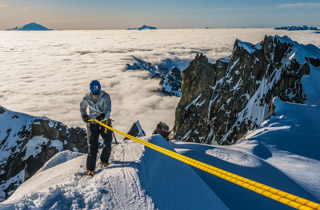Trekking Pole Benefits
Trekking Pole Benefits
Trekking Poles Pros and Cons
If you have gone on any steep hikes, you probably have already noticed that ascending with trekking poles helps set up a natural pace or rhythm while descending with trekking poles helps you spare your knees on the descent to some degree. Are there any other benefits or disadvantages to using poles?
An Austrian Study
In “Comparison of Knee Joint Forces During Downhill Walking With and Without Hiking Poles,” Roithner and others showed that the use of trekking or ski poles caused reductions of external and internal loads on the knee joint by up to 20%. This means that if you have weak knees and wish to protect them over the long term, having moderate pole support for the descents can save the knees and help prevent severe muscle soreness in the quadriceps.
Andriacchi and Mikosz (in “Muskuloskeletal Dynamics, Locomotion and Clinical Applications,” 1991) observed four times higher knee joint moments during descending stairs compared to walking on flat ground. If you have trouble walking downstairs or going down hills in the city, you will probably have even more difficulty on uneven terrain in the mountains, where steps can be steeper, more uneven, and unpredictable, and occur over longer periods.


Takeaways
What’s the best way to handle the problem of steep downhills? Strengthen, well in advance, all the muscles in the lower leg that will be needed for climbing and descending.
While trekking poles are a viable tool in the early season as you build your leg strength and endurance, you want to train yourself to be as strong as possible so the inevitable challenges in the mountains don’t cause you even greater problems.
You may also find it helpful to wear a properly fitting knee brace, though be aware that poles and braces can become a crutch if you rely too heavily on them.
If you require poles or braces for balance and stability, or for help getting yourself across challenging boulder fields, blowdowns, or scree slopes, you can’t develop your own “goat legs.” If you happen to forget your brace, or you break or lose a pole, it might become too difficult to complete the hike. Reliance on a pole also means you may lack the confidence in your balance to keep up with the others in your group.
Finally, if you rely on poles and need to hold onto tree branches or roots for stream crossings or scrambling up steep banks, the poles could become a distraction. Without properly strengthening your legs you may experience more soreness if you forget or lose your poles.
Bottom Line
The bottom line is this: trekking poles DO help reduce forces through the knee joint and can be useful for some at the start of the hiking season. However, if you will be traveling across mixed or glaciated terrain where you will need to hold an ice ax or have both hands free, develop the balance and leg strength necessary to be brace-free and pole-free if the need arises.






